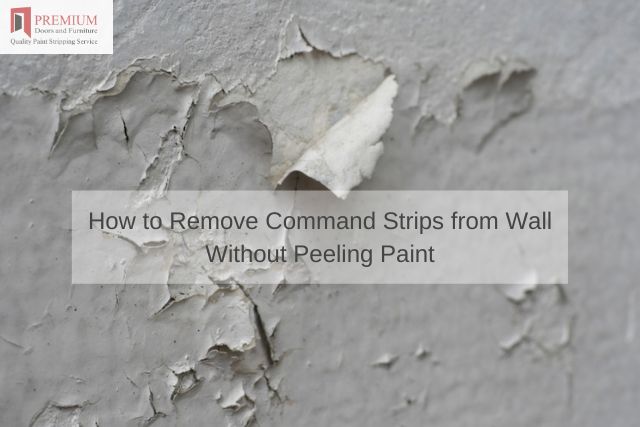Command strips have become increasingly popular in recent years as an alternative to nails and tacks for hanging items on walls. Their damage-free hanging ability makes them ideal for temporarily hanging decorations, photos, calendars, and more. However, some questions have emerged about whether they can damage painted walls when removed.
Page Contents
How Command Strips Work
Command strips utilize damage-free hanging technology that allows you to hang lightweight items on a variety of surfaces, including painted drywall, tile, metal, and glass. They come in various sizes and strengths to accommodate different weights.
The adhesive strips contain a foam padding layer and a silicone gel adhesive layer. The foam padding distributes the weight of the hung item evenly across the strip to prevent too much stress on any one point. The gel adhesive creates a strong but temporary bond so the strip can be removed without damaging surfaces.
To use a command strip, you simply clean the surface, press the adhesive strip firmly onto the wall, then press the hung item onto the paired strip. When pressed together, the silicone gel adhesive grips tightly. To remove, you slowly pull the bottom strip down off the wall at a 90° angle.
Potential for Paint Damage
When used properly on recommended surfaces, command strips should not peel paint off walls. The foam padding and silicone gel adhesive are designed to bond securely but gently so that surfaces are left undamaged upon removal.
However, there are certain situations in which command strips do have the potential to damage paint on walls:
- Using on a poorly prepared surface – Grease, dust, or soil on the wall can inhibit adhesion and cause the strip to pull off paint when removing it.
- Applying to delicate surfaces – Strips should not be used on delicate surfaces like fresh paint, wallpaper, or uncured drywall compound. These surfaces may not be secure enough to withstand removal.
- Exceeding weight limits – Overloading strips beyond their weight recommendations can cause them to detach forcefully from the wall and pull off paint.
- Pulling off incorrectly – Yanking directly outward instead of down and toward you at a 90° angle can damage paint upon removal.
Additionally, certain types of paint may be more prone to damage than others. High gloss enamels and darker, thicker paints tend to be more delicate. Flat or matte latex paints generally allow for cleaner removal of command strips.
Tips for Preventing Paint Damage
You can take certain precautions when using command strips to ensure they do not peel paint off the wall:
- Properly prepare the surface – Clean the area with isopropyl alcohol and let it dry completely before applying strips. This helps maximize adhesion.
- Use on recommended surfaces only – Avoid using on freshly painted walls, wallpaper, or delicate surfaces.
- Select the right size – Choose a strip size and weight rating suitable for the item being hung.
- Press firmly – Apply a strong pressure across the entire strip for 30 seconds after affixing to the wall and hung item for optimal bonding.
- Pull down and inward – When removing, keep strips at a 90° angle and pull down rather than out to protect paint.
- Work slowly – Take your time removing strips by gently rolling them off the wall rather than quickly ripping.
Taking these precautions can help minimize the risk of paint damage when using command strips. It’s also a good idea to test one out in an inconspicuous area first.
Alternatives That Won’t Damage Paint
If you want to avoid any risk of paint damage, there are some alternatives to command strips that can securely and removably hang items on walls:
- Painter’s tape – Wide tape designed not to harm painted surfaces when removed.
- 3M picture hanging strips – Foam adhesive strips similar to command but lighter duty.
- Magnetic hooks – Adhere magnets to items and hang on magnetic paint, metal strips, or sheets.
- Temporary adhesive wall hooks – Vinyl hooks with repositionable, non-damaging adhesive.
- Over-the-door hangers – Sit over the top of doors without needing attachment.
For permanent placement of heavier items that require screws or nails, you can fill holes with spackle when removing items to protect walls.
Removing Command Strips That Pulled Off Paint
If you do happen to experience paint damage when removing command strips, don’t panic. Here are some tips for repairing the spots where paint was pulled off:
- Scrape away any loose paint – Use a plastic spackle knife to gently scrape off any lifted or cracked paint edges around the damaged spot.
- Sand the area – Lightly sand the damaged spot with fine sandpaper to feather the edges and create a smooth surface.
- Clean and dry the wall – Wipe away dust with a dry cloth and let the area fully dry before painting.
- Spot prime if needed – For exposed drywall or an oil-based spot, spot prime before painting.
- Spot paint the area – Use a small paintbrush to spot paint the damaged area with matching paint, feathering the edges.
- Allow paint to dry fully – Give the spot paint several hours or overnight to fully cure before touching up.
With this repair method, the spot should blend into the surrounding paint for a seamless look. Prevent future damage by using painter’s tape behind strips in delicate areas.
Conclusion
When used correctly, command strips do not typically peel paint off walls upon removal. However, poor surface prep, delicate paints, or user error can lead to paint damage in some cases. Your best bet is to follow all preparation and removal directions precisely. Consider lighter duty options for fresh paints or wallpaper. And if minor damage does occur, you can touch up spots with spackle and paint for a quick fix.
